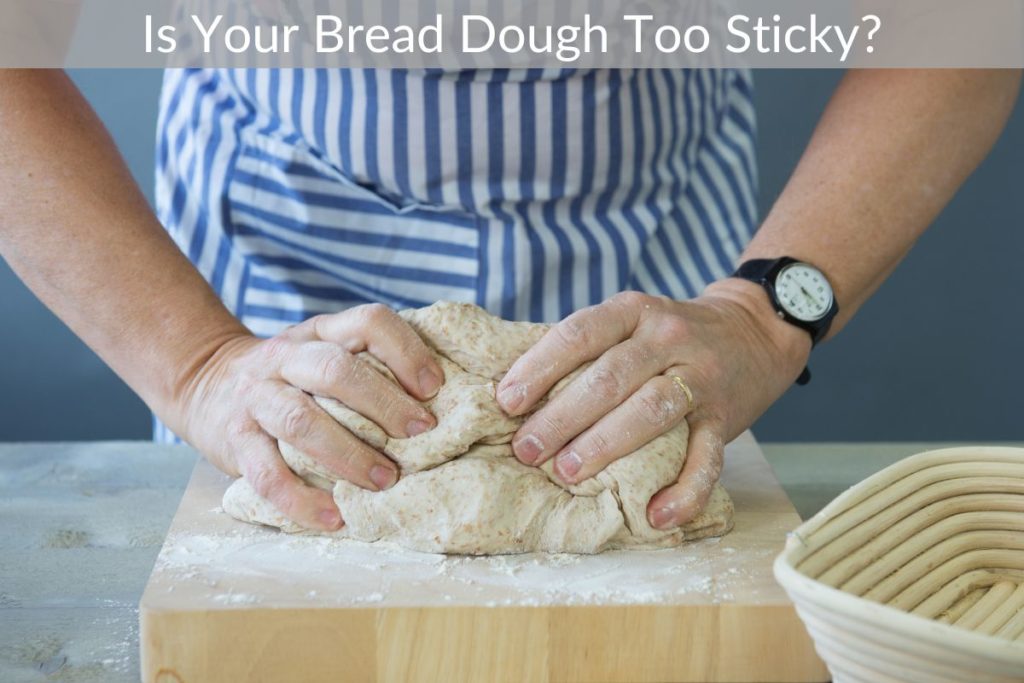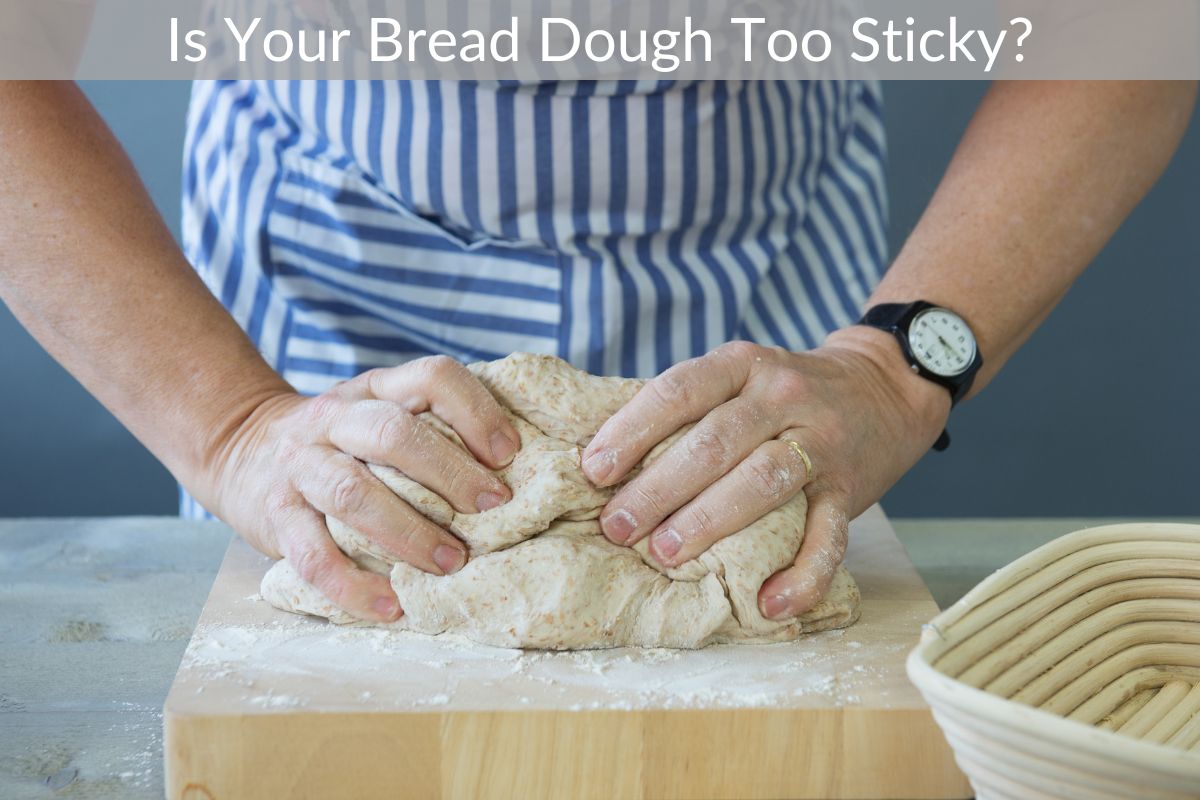The answer to a question like this is simple: If you’re having trouble making your bread dough stick to your hands, you’ve probably added too much water to the recipe. You need to add a few tablespoons more flour to make the dough stick to your hands less.
Also, if the dough feels firm when you poke it with a finger, it’s probably too sticky. You can fix the problem by adding a bit of flour or oil to your hands.

Less water = less stickiness
There are several factors that influence the amount of water that is required for a dough to be moist and stick to a work surface. The first is the type and quality of the flour. A flour with high protein content will require more water for the dough to be moist and stick to a work surface. Another factor is the type of climate in which the flour is stored. When the flour is stored in a humid area, moisture content will be higher, which will make the dough less sticky.
The next factor to consider is the amount of water to use. Generally, cold water will release more gluten than warm water, leading to a more sticky dough. Cold water also releases more gluten into the dough, making it tougher to work with and difficult to knead. Warm water is preferable for mixing ingredients. This will help the dough retain its structure and maintain its lightness. If you want to avoid sticky dough, try using more water instead.
The amount of water is also important. Some dough recipes have too much water, which results in a very wet mess. If possible, hold back a few drops of water when mixing ingredients. A rule of thumb is that you should use 60% of the water for kneading the dough. The remaining water can be added in small increments, as you knead it.
Another important factor is how long you knead the dough. The more time you spend on kneading, the less sticky the dough will become. A sticky dough is not necessarily a bad thing; it can just be very tacky. If you can handle it, there is no reason to be disheartened. Sticky dough is a necessary part of bread making. You can still achieve a perfect result.
When determining how much water you should use for kneading bread dough, it is best to experiment with different types of flour. Different types of flour will absorb moisture differently, so you should adjust accordingly. As you become more experienced, you will need less water, but it is always better to add more if you are unsure. It’s not easy to make sourdough, so experiment with it and see how you like the taste and texture.
Don’t forget to add flour. If the dough is too sticky, you will need a little flour to prevent it from sticking. A little flour before kneading will help you get the right texture and prevent it from being sticky. Adding flour after the first rise will also make it less sticky. Once the dough has risen, you can sprinkle it with a little more flour.
If your dough is sticky, you can let it rise a second time before using it. This will make it easier to handle because the flour will have absorbed the water. Don’t worry, if you’re too tired, you can substitute resting for kneading the dough. Then, cut the dough into strips and repeat for another two minutes. It will be easier to handle if you’ve rested it.
The second factor that contributes to sticky dough is the water content. Many people think that adding more flour makes the dough less sticky, but this is not always the case. Instead, use a mix of flour and water and use less water than the recipe calls for. The dough will become easier to handle when less water is added to it. The key to creating great loaves of bread is to make sure that your ingredients are weighed correctly. You can also make sure that the dough is moist but not too moist.
More water = less stickiness
When baking bread, more water is a good thing. This is because it increases the water holding capacity of the dough, making it less sticky. However, too much water can make the dough stickier. Water that contains high levels of calcium can make the dough too soft. Mineral water is generally regarded as having the appropriate hardness level for baking bread. Therefore, it is better to use water that has lower calcium content.
The amount of water required for making bread dough depends on the weather and other factors. In hot and humid areas, it is advisable to hold back at least 50 g of water from the recipe. If the dough feels stiff after the addition, add water gradually. Always measure by weight and make notes on your results. For ciabattas and sourdoughs, use 60 percent water. When adding more water, it is better to add it a few drops at a time.
If the dough is sticky and a bit tacky to the touch, it needs more flour. However, if it isn’t sticky to the touch, you’re likely using too much flour. You should adjust the amount of flour according to the type of bread you’re baking. In general, the more water you add, the less sticky the dough will be. However, you should still keep in mind that a higher water content means a more tender and delicious loaf of bread.
It’s important to understand the differences in water content in different climates. When you bake bread, different flour brands will have different levels of protein. For instance, in a humid climate, the dough may have absorbed a lot of water before adding water. As a result, it becomes stickier. For this reason, it’s a good idea to use flours that contain a high proportion of water.
If you want to bake a loaf of bread with less gluten, you should add a little flour to the dough. If the dough is too sticky, you’ll be risking the quality of the finished product. Adding more flour is not the best option, as it will make the bread harder and less tender. A dry dough is not suited for baking, so only add the extra flour if you really need it.
Water absorption is important to ensure a proper fermentation. This happens in the dough by adding extra water. The higher the water content in flour, the more water it needs. But, the water content in flour depends on its quality. For instance, flour that is stored in a humid environment will have more water than flour that is kept in a dry environment. A large portion of flour needs more water than a dry one does, but it’s not crucial to add additional water to the dough.
If your dough is sticky and won’t leave your hands, consider making another rise. A second rise will help reduce the amount of moisture and stickiness in the dough. Leaving it out to prove too long will make it wet and lose its structure. You can also try using all-purpose flour for this second rise. It’s easier to shape a dough that has been allowed to rest for more than half an hour.
A good rule of thumb is to use a low-hydration dough. A low hydration dough is easy to knead and shape, and you can gradually increase the water content. To avoid problems during shaping or moving the dough, you can add more flour. However, you should avoid adding too much flour as it will make the dough sticky. Just remember that it’s better to start with a low hydration level for beginners.
Another important rule is to fold your dough more than once. It can help the dough absorb water and make it easier to handle. While the number of folds you do will depend on your recipe, the principle is the same. Periodically folding the dough will turn a sticky wet dough into a more airy and strong one. It’s important to make sure your work surface is clean and free of flour.

